The blame for this post falls directly onto the shoulders of The Akamai Knitter and LaceFreak Jane. I refuse to accept any responsibility for my actions, because it's Not My Fault.
After observing (with tears in my eyes and lust in my heart) the spindle acquisitions of these two blameful beings, I was forced, much against my will, to order a 2" Karelian birch Bosworth spindle (about 18 grams) and two ounces of 80% merino, 20% cashmere from Miss Babs.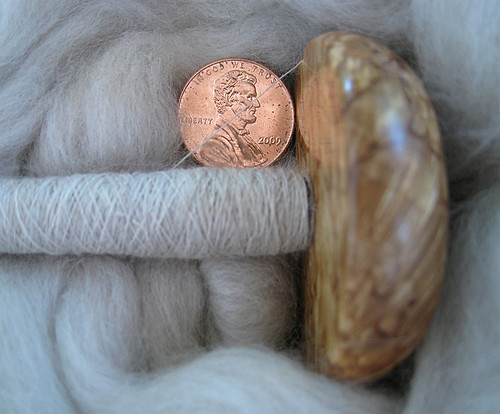
After a few false starts, due to the fact that I had never used a top whirler, I was happy to discover that spinning is like riding a bicycle. It didn't take long before I was humming along in my personal comfort zone of 80 wpi.
After a few days of spinning plain gray, my eyeballs itched for some color. A little red dye, a little fiber...
I also ordered a bit of angora/merino top from Susan's Spinning Bunny. In a remarkable display of postal schizophrenia, the package was both refused and signed for on the same day. Somehow, it was apparently refused here and returned to Susan, but when we looked up the tracking number, the post office said it was signed for and received on 6/18.
I questioned Harry closely about this, and the best explanation we have is that Harry answered the door, whereupon the mail carrier dropped her electronic gizmo, and ran screaming back to the car with the package. Harry carefully signed for the package by stomping on the gizmo's touch screen, and then wandered over to the hammock with a cold beer.
Meanwhile, after inhaling several tablets of Xanax, the postal carrier snuck back up to the front door, retrieved her gizmo, and then screeched out of the driveway with the package beside her.
If anyone has a better explanation, I would sure love to hear about it.
Tuesday, June 23, 2009
The Blame Game
Posted by
fleegle
at
9:11 AM
26
comments
![]()
Wednesday, June 10, 2009
Purl Decreases Demystified
If you hunt around the Internet in search of purl decreases, you will probably encounter only two: the right-slanting single decrease (P2tog) and the right-slanting double decrease (P3tog). There may be times, however, when you need single or double left-slanting purl decreases or a double purl decrease with no slant at all.
Most commonly, you will encounter these snarky decreases if you are knitting garter-stitch lace in-the-round, for example, a borders-outward shawl in a single piece. To maintain garter stitch in the round, alternate rows must be purled (unless you are cheating and going to futz one corner so you can knit back and forth). And if you are knitting Shetland lace, there's probably no way you will escape having to work double purl decreases with no slant. Central double decreases abound in Shetland patterns.
After perusing my standard books, such as Barbara Walker's Charted Knitting Designs, and rejecting most of the solutions as kinda awkward, I fiddled around with a few different ways of accomplishing these dratted decreases. Some people hate purling through the back of stitches. Others don't find this uncomfortable. Please try all these methods and decide which one works best for you.
Left-Slanting Single Purl Decrease
The most common method is purling through the back of two stitches thusly: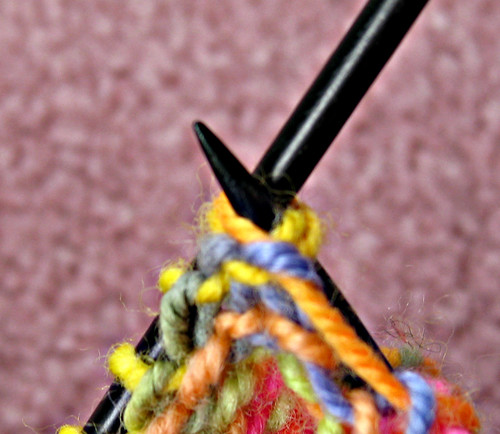
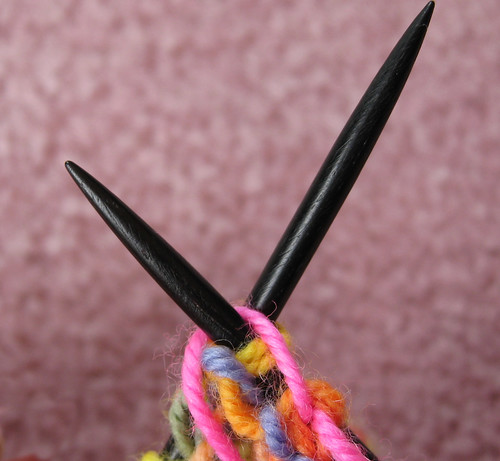
the finished stitch on the purl side: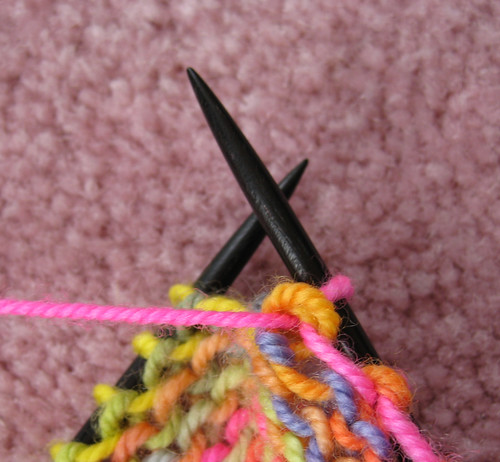
And finished stitch on the knit side:
If you hate this process, then slip two stitches, one at a time, knitwise.
first stitch slipped...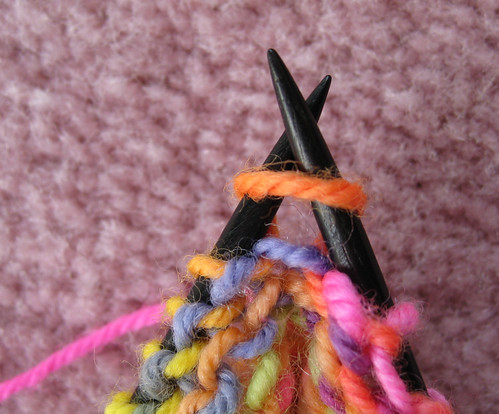
.... second stitch slipped.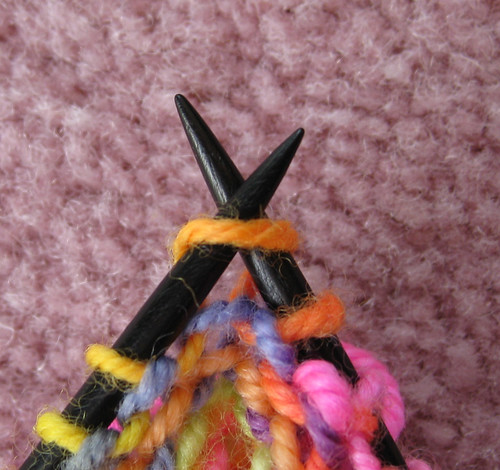
Then insert the tip of the left needle through the front of these two stitches (which are now on the right needle)...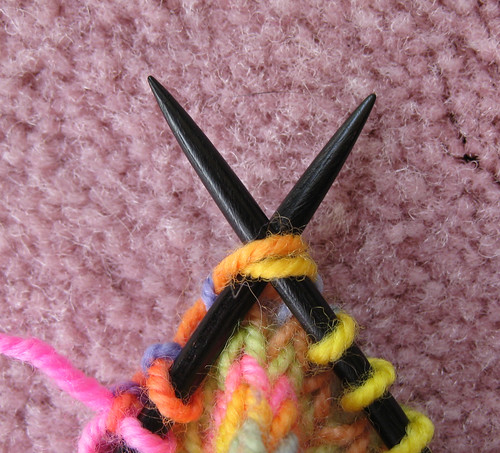
and slip them back to the left needle as a unit. Notice that the stitches have switch positions.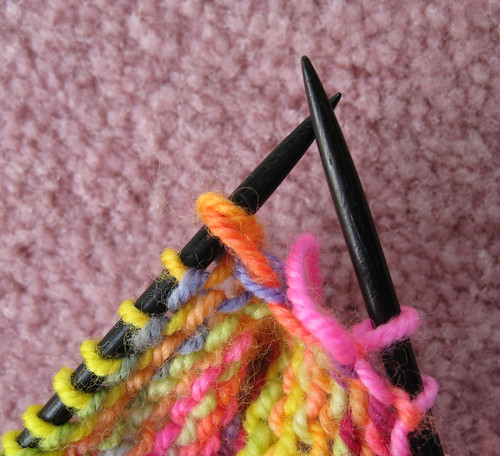
Purl these two stitches together.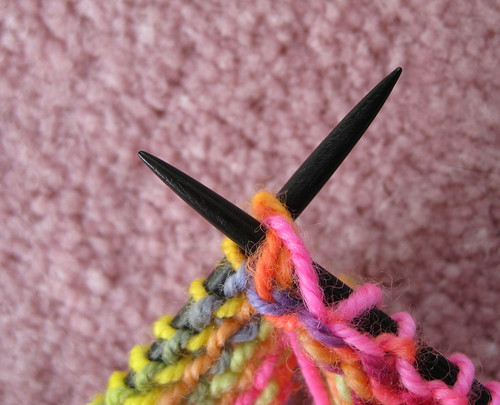
Here's the finished stitch on the purl side: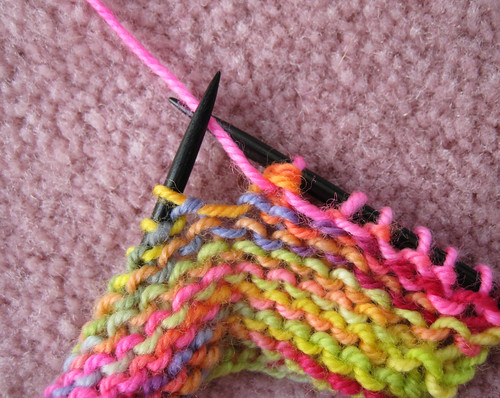
And here's the knit side:
The second method seems easier to me for purling together two stitches when one of them is a yarnover. But sometimes I just purl through the back. Which method I choose depends a great deal on the yarn--some yarns don't like the back stitch, some don't like the slip-and-flip business. Take your pick :)
Left-Slanting Double Purl Decrease
This is just an extension of the single decrease, but with added torment. No matter which method you use, the process is awful. My favorite method, not described here in detail, is to avoid patterns that require me to do this.
Anyway.
You can purl through the back of three stitches: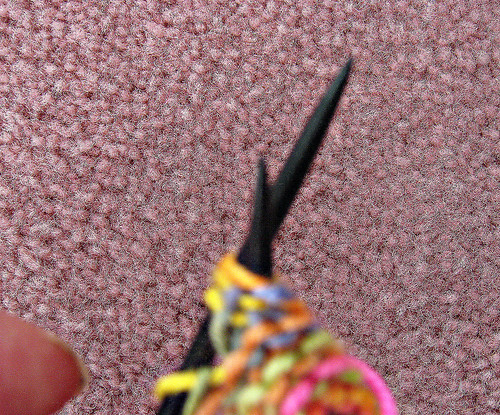

Here's what it looks like on the knit side:
Or, slip three stitches, one at a time, purlwise.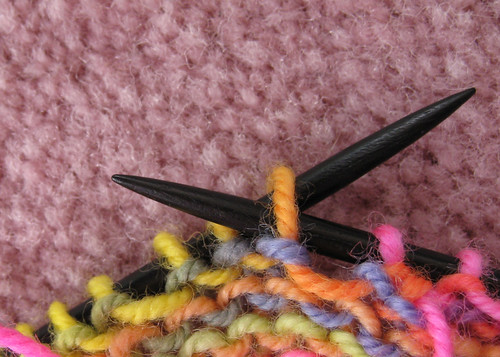
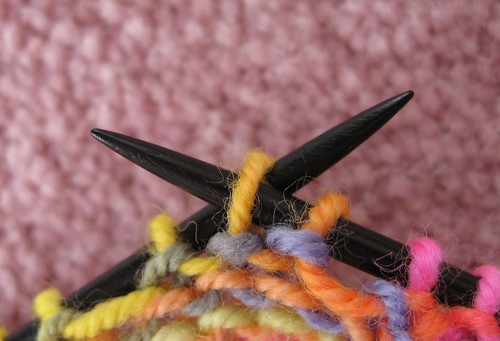

Then insert the tip of the left needle through the front of these three stitches (which are now on the right needle),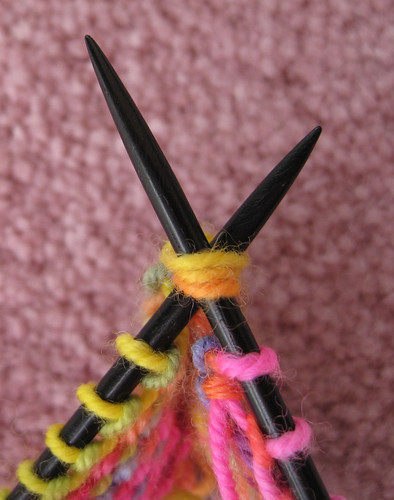
and slip them back to the left needle as a unit.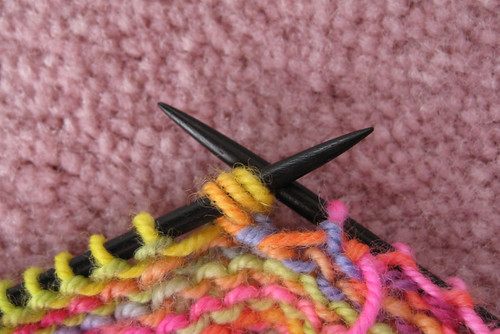
Then purl these three stitches together.
Here's the purl side: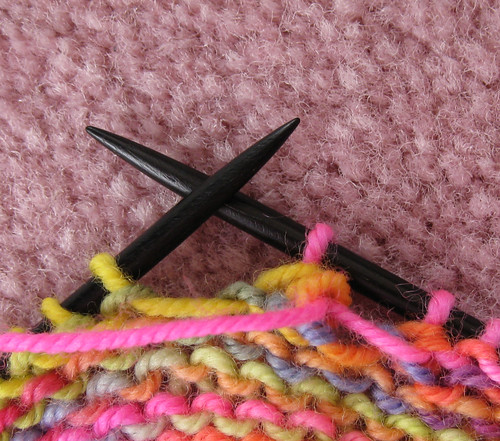
The he knit side looks the same as knitting 3 stitches together through the back loops as shown above, so I didn't take another photo.
Yet another method is described in the Walker book. Purl two stitches together. Keeping the yarn in front, put the stitch back on the left-hand needle. Pass the next stitch over this one, then transfer to the right-hand needle. I frankly don't care for the way it looks, but it's simpler to execute.
Double-Purl Decrease with No Slant (Central Double Purl Decrease)
This one is actually pretty easy. The literature I encountered had some wacky solutions; I think my answer is simpler. The first two steps are identical to the Left-Slanting Single Purl Decrease shown above.
Slip two stitches, one at a time, knitwise.
Then insert the tip of the left needle through the front of these two stitches (which are now on the right needle), and slip them back to the left needle as a unit.
Purl three stitches together (the two you slipped and flipped, plus one on the left-hand needle).
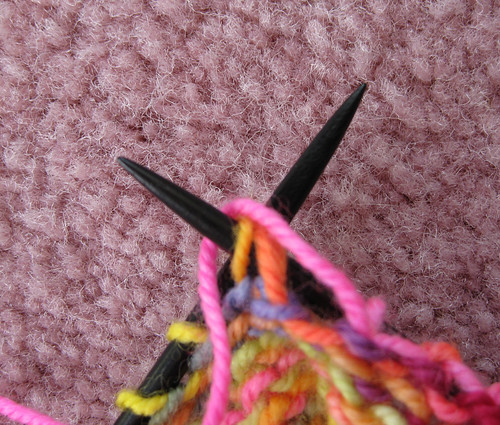
Here's the finished decrease on the purl side:
and the knit side: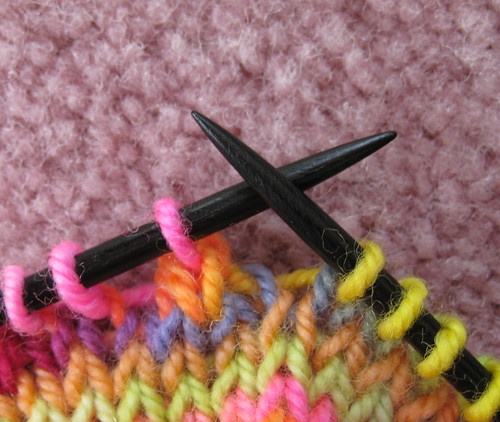
Posted by
fleegle
at
12:18 PM
22
comments
![]()
Wednesday, June 3, 2009
Queen Ring Shetland Center--Complete!
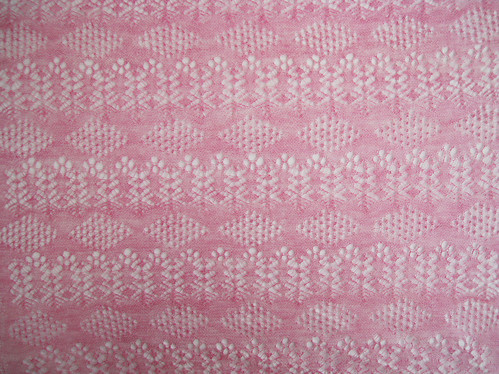
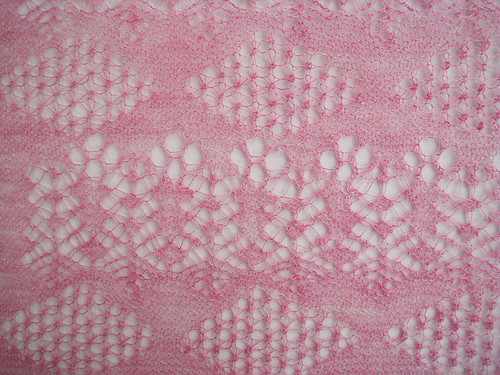

And the yarn! Technically, it's 52/2 60% merino, 20% cashmere, 20% silk. But to knit with it--it's incredible! It's stupendous! It's incredible! Oh whoops, I said that. It's bouncy. It's silky. It's soft. It's everything a gossamer yarn is supposed to be. It deserves a niche in the Yarn Hall of Fame.
Alas, I bought the only skein in the universe on my trip to Japan last year. I was so besotted with it that I decided that I had to have more.
I sent a sample to a mill in China and asked what their minimum order was for a custom spin. The bad news was that I needed to buy 50 kilos. Much as I loved it, I didn't love it 50 kilos-worth. Each kilo has 25,000 meters, and, while I am a fairly robust knitter, I couldn't see my way to stashing 1,250,000 meters of yarn. There are limits, even for me.
I figured there were probably a few other people who might go in with me on the buy. I posted the information in the Heirloom Knitting group on Ravelry and placed a little Post-It note next to the computer to write down the names of the five or six people I figured would want a kilo or two. To my utter bafflement, I had to quickly switch to a spreadsheet to keep track of the orders.
The good news is that I have 100 kilos subscribed. In about a month, I will be able to roll around in the stuff (just kidding, guys, really!)
The thought of 200 pounds of yarn landing in my yard is a bit daunting, but a dear lady is driving down from South Carolina to help us pack and ship the 2,500,000 meters of the yarn I am naming Phoenix.
Of course, Harry said he would help out by providing the entertainment. Unfortunately, he has developed a crush on Al Jolson. The house reverberates with the clickity-click of eight little feet tap-dancing on the dining room table. I can't wait to see what he has in store for us as we wrestle with mailing bags. Hmm, perhaps he will fit in one of them. (Joke--it's a joke!) I promise that nobody will open their package and find a tap-dancing spider in it. Unless, of course, you want one.
Posted by
fleegle
at
4:38 PM
28
comments
![]()
Labels: King Bat, Knitting, lace, Queen Ring
